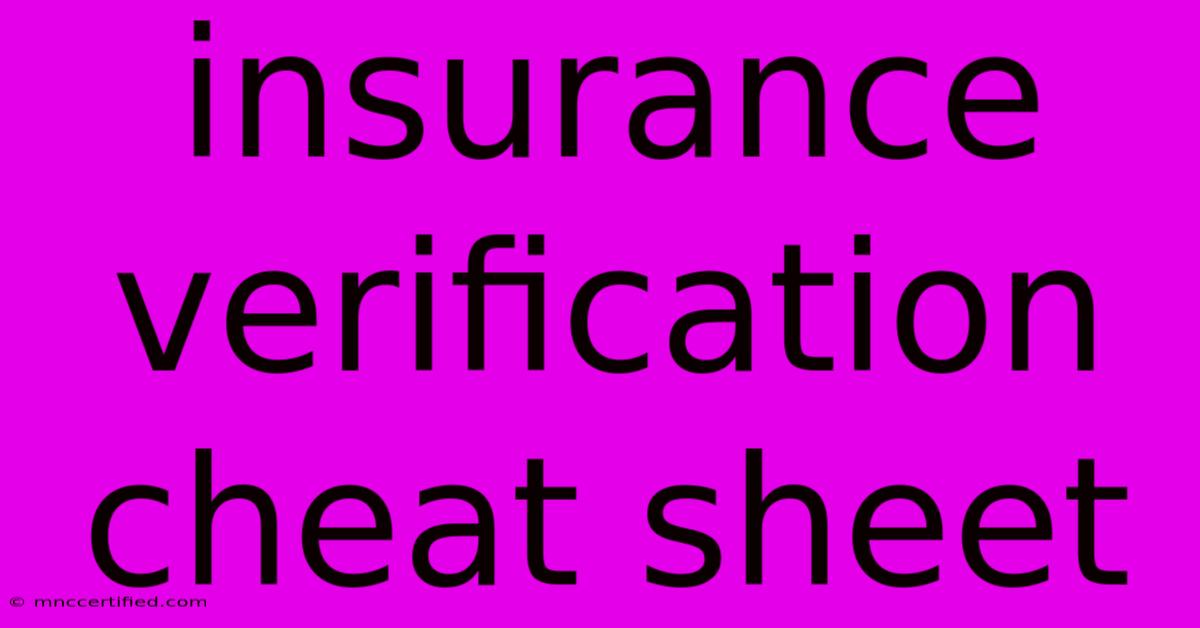Insurance Verification Cheat Sheet

Table of Contents
Insurance Verification Cheat Sheet: A Guide for Healthcare Providers
Verifying insurance coverage can be a complex and time-consuming process for healthcare providers. This cheat sheet provides a streamlined approach to ensure accurate and efficient insurance verification, minimizing denials and maximizing reimbursements.
Understanding the Importance of Insurance Verification
Accurate insurance verification is critical for several reasons:
- Reduced Denials: Properly verifying insurance coverage before providing services significantly reduces the likelihood of claims being denied due to incorrect or missing information. Denied claims mean lost revenue and increased administrative burden.
- Improved Cash Flow: Faster claim processing and fewer denials lead to improved cash flow, allowing your practice to operate more smoothly.
- Patient Satisfaction: A smooth insurance verification process contributes to a positive patient experience, fostering trust and loyalty.
- Compliance: Accurate insurance verification is essential for compliance with healthcare regulations and avoiding potential penalties.
The Insurance Verification Process: A Step-by-Step Guide
This cheat sheet outlines the key steps involved in the insurance verification process:
1. Obtain Necessary Patient Information
Before initiating the verification process, gather the following information from your patient:
- Full Name: Including any middle names or initials.
- Date of Birth: Accuracy is vital.
- Insurance Provider Name: Including the full legal name of the insurer.
- Insurance ID Number: The unique identifier assigned to the patient by their insurer.
- Group Number: If applicable.
- Employer Information: If applicable, including employer name and address.
- Policy Effective and Expiration Dates: To confirm coverage is active.
2. Choosing Your Verification Method
You have several options for verifying insurance:
- Online Verification: Many insurers offer online portals for real-time verification, providing immediate confirmation of coverage details. This is often the fastest and most efficient method.
- Phone Verification: Calling the insurance provider directly allows for clarification on specific details or complex situations.
- Fax Verification: While less efficient, fax verification remains a common method for some insurers.
3. Verify Coverage Details
Regardless of your chosen method, confirm the following crucial details:
- Eligibility: Confirm the patient is currently covered under the specified policy.
- Coverage Details: Determine the type of coverage (e.g., HMO, PPO), copays, deductibles, and any pre-authorization requirements.
- PCP Information: If applicable, verify the patient's primary care physician (PCP) is within the network.
- Pre-authorization Requirements: Determine if pre-authorization is needed for specific services. Failure to obtain necessary pre-authorization can lead to claim denial.
4. Document Everything!
Thorough documentation is essential. Maintain a detailed record of:
- Date of Verification: Important for tracking purposes.
- Method of Verification: Online, phone, or fax.
- Person Contacted: If applicable, note the name and title of the individual you spoke with.
- Verification Confirmation Number: A unique number provided by the insurer to confirm the verification.
- Key Coverage Details: Record all relevant information obtained, including eligibility, copay, deductible, etc.
Common Challenges and Solutions
- Incorrect Information: Always double-check the patient-provided information for accuracy.
- Changing Insurance Information: Encourage patients to update their insurance information promptly to avoid delays and denials.
- Network Issues: Verify that the patient's provider is in-network for the specific insurance plan.
- Pre-authorization Denials: Address any pre-authorization denials immediately and appeal as necessary.
Utilizing Technology for Insurance Verification
Many healthcare practices leverage technology to streamline insurance verification. Electronic health record (EHR) systems often integrate with insurance clearinghouses, automating much of the process. Consider exploring such solutions to improve efficiency and reduce administrative burden.
This cheat sheet provides a foundation for efficient insurance verification. Remember to adapt your process to your specific needs and stay updated on industry best practices and payer-specific requirements. Consistent adherence to this process will contribute to a smoother workflow, improved revenue cycle, and enhanced patient satisfaction.

Thank you for visiting our website wich cover about Insurance Verification Cheat Sheet. We hope the information provided has been useful to you. Feel free to contact us if you have any questions or need further assistance. See you next time and dont miss to bookmark.
Featured Posts
-
Portugal Advances To Nations League Quarters
Nov 16, 2024
-
Denmark Vs Spain Live Match Uefa Nations League
Nov 16, 2024
-
Insurance Defense Attorney Near Me
Nov 16, 2024
-
Tyson Vs Paul Fight Time And How To Watch
Nov 16, 2024
-
Suspended Romania 0 0 Kosovo Nations League
Nov 16, 2024